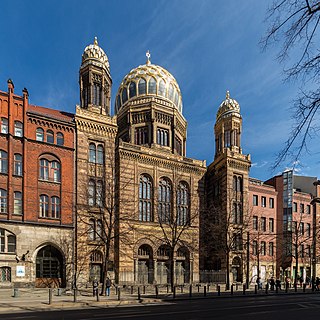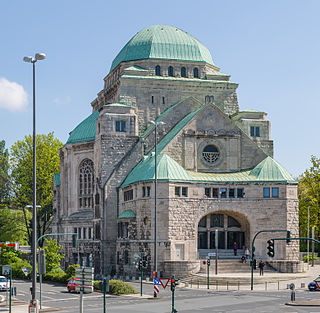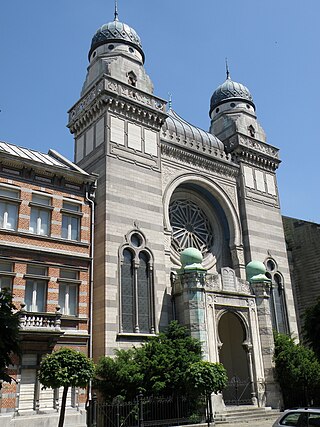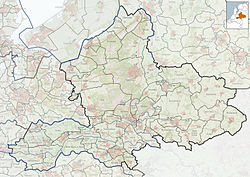
Aalten is a municipality and a town in the eastern Netherlands. The former municipalities of Bredevoort (1818) and Dinxperlo (2005) have been merged with Aalten.

The New Synagogue on Oranienburger Straße in Berlin is a mid-19th century synagogue built as the main place of worship for the city's Jewish community, succeeding the Old Synagogue which the community outgrew. Because of its Moorish style and resemblance to the Alhambra, the New Synagogue is an important architectural monument in Germany.

The Old Synagogue is a former Reform Jewish congregation and synagogue, located at Steeler Straße 29, in Essen, in the state of North Rhine-Westphalia, Germany. The former synagogue was repurposed in 1960 as a Jewish museum.

The history of the Jews in the Netherlands largely dates to the late 16th century and 17th century, when Sephardic Jews from Portugal and Spain began to settle in Amsterdam and a few other Dutch cities, because the Netherlands was an unusual center of religious tolerance. Since Portuguese Jews had not lived under rabbinic authority for decades, the first generation of those embracing their ancestral religion had to be formally instructed in Jewish belief and practice. This contrasts with Ashkenazi Jews from central Europe, who, although persecuted, lived in organized communities. Seventeenth-century Amsterdam was referred to as the "Dutch Jerusalem" for its importance as a center of Jewish life. In the mid 17th century, Ashkenazi Jews from central and eastern Europe migrated. Both groups migrated for reasons of religious liberty, to escape persecution, now able to live openly as Jews in separate organized, autonomous Jewish communities under rabbinic authority. They were also drawn by the economic opportunities in the Netherlands, a major hub in world trade.

The history of the Jews in Indonesia began with the arrival of early European explorers and settlers, and the first Jews arrived in the 17th century. Most Indonesian Jews arrived from Southern Europe, the United Kingdom, the Netherlands, Belgium, Germany, France, the Middle East, North Africa, India, China, and Latin America. Jews in Indonesia presently form a very small Jewish community of about 500–1,000, from a nadir of about 20 in 1997. Judaism is not recognized as one of the country's six major religions, however its practices are allowed under Perpres 1965 No. 1 and article 29 paragraph 2 of the Constitution of Indonesia. Therefore, members of the local Jewish community have to choose to register as "Belief in One Almighty God" or another recognized religions on their official identity cards.
The Nederlands-Israëlitisch Kerkgenootschap (NIK) is the umbrella organisation for most Ashkenazi Jewish communities in the Netherlands, and is Orthodox in nature, while to be described as traditional in outlook. The expression Orthodox, is for the Dutch situation at least, of a later date than the existence of the congregations that make up the NIK and the NIK itself. The Rabbi of the NIK is Rabbi Dr. Raphael Evers. In total, the NIK has some 20 rabbis actively working in 18 congregations throughout the country, serving some 5,000 Jews.

Beit Ha'Chidush, abbreviated as BHC is a Progressive Jewish congregation, located in Amsterdam, in the North Holland region of The Netherlands. The congregation was founded in 1995 by predominately expatriate Jews with secular and religious backgrounds who wanted to create a welcoming, inspiring and renewed Jewish congregation.

The Portuguese Synagogue, also known as the Esnoga, or Snoge, is an Orthodox Jewish congregation and synagogue, located at Mr. Visserplein 3 in Central Amsterdam, Amsterdam, in the North Holland region of The Netherlands. The synagogue was completed in 1675. Esnoga is the word for synagogue in Judaeo-Spanish, the traditional Judaeo-Spanish language of Sephardi Jews.

The Hollandse Synagoge, officially the Synagogue Shomré Hadas, and also known as the Bouwmeester Synagoge, is an Orthodox Jewish congregation and synagogue, located on Bouwmeestersstraat 7, in Antwerp, Belgium. Whilst the first Jews arrived in Antwerp in the 14th century, the congregation was not officially established until 1816. Descendants of Jews who came to Antwerp from the Netherlands in the early 19th century, built the synagogue in 1893 and it was the first large synagogue in Antwerp.

The Great Synagogue, was a synagogue of the Jewish Community of Danzig in the city of Danzig, Germany. It was built in 1885–1887 on Reitbahnstraße, now Bogusławski Street. It was the largest synagogue in the city, and was demolished by the Free City authorities in May 1939.

Epe is a village in the district of Borken in the state of North Rhine-Westphalia, Germany. It is located on the Dutch border, approx. 10 km east of Enschede. It has been part of the municipality of Gronau since 1975. Epe has a population of about 16,000 and is located on the Dinkel River.

The Delft Synagogue is a Reconstructionist Jewish congregation and synagogue, located at Koornmarkt 12, in the city of Delft, in the South Holland region of The Netherlands. Designed by L. Winkel in the Neoclassical style, the synagogue was completed in 1862, fell into disuse after World War II, was subsequently restored and reconsecrated from 1974.

The history of the Jews in Amsterdam focuses on the historical center of the Dutch Jewish community, comprising both Portuguese Jews originally from both Spain and Portugal and Ashkenazi Jews, originally from central Europe. The two separate groups have had a continuing presence since the seventeenth century. Amsterdam has been called a Jerusalem of the West and the "Dutch Jerusalem". The Holocaust in the Netherlands devastated the Jewish community, with the Nazis murdering over 80% of Amsterdam's 79,000 Jews, but the community has managed to rebuild a vibrant and living Jewish life for its approximately 15,000 present members.

The Kassel Synagogue was a former Jewish congregation and synagogue, located on Untere Königsstraße, in Kassel, Hesse, Germany. The second synagogue for the congregation was completed in 1839 and set ablaze by the Nazis on November 9, 1938, during the Kristallnacht pogrom.
The Jodenbuurt is a neighbourhood of Amsterdam, Netherlands. For centuries before World War II, it was the center of the Dutch Jews of Amsterdam — hence, its name. It is best known as the birthplace of Baruch Spinoza, the home of Rembrandt, and the Jewish ghetto of Nazi occupation of the Netherlands.

The Great Synagogue of Deventer is a former Jewish congregation and synagogue, located at Golstraat 23, in the city of Deventer, in the Overijssel region of The Netherlands. Designed by J. A. Mulock Houwer in a mix of the Renaissance Revival and Moorish Revival styles, the synagogue was completed in 1892.
The Dutch Israelite Religious Community of The Hague is the Ashkenazi Orthodox Jewish community in The Hague and is a member of the Nederlands-Israëlitisch Kerkgenootschap (NIK).

The Görlitz Synagogue is a Jewish congregation and synagogue, located on Otto-Müller-Straße, in Görlitz, Germany. Built between 1909 and 1911 in the Art Nouveau style, the synagogue was the main place of worship for the city's Ashkenazi Jewish community. Despite an arson attack, the synagogue was one of the few synagogues in the area to survive Kristallnacht, sustaining only minor damage. The damage was lessened as firefighters ignored the Nazi German orders to let the synagogue burn. With the city's Jewish population depleted, the unused synagogue became a ruin in the following decades.

The Gerard Doustraat Synagogue is an Orthodox Jewish congregation and synagogue, located at Gerard Doustraat 238, in the de Pijp neighborhood of South Amsterdam, in North Holland, the Netherlands. Designed by architect E. M. Rood in the Renaissance Revival style, the synagogue was completed in 1892.

The Synagogue of Anderlecht, officially the Synagogue of the Orthodox Jewish Community of Brussels, and also known as the Israelite Orthodox Synagogue of Cureghem, is an Orthodox Jewish synagogue, located in the heart of the former Jewish quarter of Cureghem/Kuregem, at 67A, rue de la Clinique/Kliniekstraat, in the municipality of Anderlecht, Brussels, Belgium. The synagogue is the main synagogue of the Israelite Orthodox Community of Brussels. It can be accessed from Clemenceau metro station on lines 2 and 6 of the Brussels Metro.

















